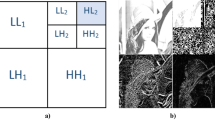Abstract
This paper presents a new algorithm for blind image watermarking which has a high robustness against common image processing attacks such as noise addition (Gaussian noise, Salt & Pepper noise, Speckle noise and etc.), JPEG and JPEG2000 compressions, Histogram Equalization, Average and Gaussian filters, Scaling and Cropping. According to this fact that a watermark with about 70 bits is enough for copyright protection, consequently in this paper a small watermark (64 bits) have been double expanded into multi larger meaningful bits with applying BCH error correction code and Spread Spectrum technique in order to reduce errors in extraction phase. Approximation subband of two levels DWT transform is divided into non-overlapping blocks and high frequency coefficients of DCT transform of each block is used for embedding the watermark. Embedding technique, which is used in this paper, is Spread Spectrum. Correlation between some coefficients of each embedded block and two predefined groups of random bits is used for watermark extraction, so this method is blind and does not need to the original image or additional information in extraction phase. Another idea, which is used in this paper, is calculating different gain factors for each block of approximation subband according to the texture of each block. Consequently this method allocates smaller gain factors to smooth blocks and larger gain factors to texture and rough blocks. So, manipulating in image will be more robust and imperceptible.







Similar content being viewed by others
References
Benoraira A, Benmahammed K, Boucenna N (2015) Blind image watermarking technique based on differential embedding in DWT and DCT domains. EURASIP J Adv Signal Process 2015(1):1–1
Cox I, Miller M, Bloom J, Fridrich J, Kalker T (2007) Digital watermarking and steganography. Morgan Kaufmann, p 23
Chugh G (2013) Information hiding-steganography & watermarking: a comparitive study. Int J Adv Res Comput Sci 4(4):1
Cedillo-Hernandez A, Cedillo-Hernandez M, Garcia-Vazquez M, Nakano-Miyatake M, Perez-Meana H, Ramirez-Acosta A (2014) Transcoding resilient video watermarking scheme based on spatio-temporal HVS and DCT. Signal Process 97:40–54
Cox IJ, Kilian J, Leighton FT, Shamoon T (1997) Secure spread spectrum watermarking for multimedia. IEEE Trans Image Process 6(12):1673–87
Chu CC, Lin YM, Yang CH, Chang HC (2012) A fully parallel BCH codec with double error correcting capability for NOR flash applications. In: 2012 IEEE International Conference on Acoustics, Speech and Signal Processing (ICASSP). IEEE, pp 1605–1608
Das C, Panigrahi S, Sharma VK, Mahapatra KK (2014) A novel blind robust image watermarking in DCT domain using inter-block coefficient correlation. AEU-Int J Electron Commun 68(3):244– 53
Ghosh S, Ray P, Maity SP (2009) Spread spectrum image watermarking with digital design. In: Advance Computing Conference, 2009. IACC 2009. IEEE International. IEEE, pp 868–873
Horng SJ, Rosiyadi D, Fan P, Wang X, Khan MK (2014) An adaptive watermarking scheme for e-government document images. Multimed Tools Appl 72 (3):3085–103
Horng SJ, Rosiyadi D, Li T, Takao T, Guo M, Khan MK (2013) A blind image copyright protection scheme for e-government. J Vis Commun Image Represent 24(7):1099–105
Khan A, Siddiqa A, Munib S, Malik SA (2014) A recent survey of reversible watermarking techniques. Inf Sci 279:251–72
Khalili M (2015) DCT-Arnold chaotic based watermarking using JPEG-YCbCr. Optik-Int J Light Electron Opt 126(23):4367–71
Lagzian S, Soryani M, Fathy M (2011) A new robust watermarking scheme based on RDWT-SVD. Int J Intell Inf Process 2(1):22–9
Li C, Zhang Z, Wang Y, Ma B, Huang D (2015) Dither modulation of significant amplitude difference for wavelet based robust watermarking. Neurocomputing 166:404–15
Makbol NM, Khoo BE (2013) Robust blind image watermarking scheme based on redundant discrete wavelet transform and singular value decomposition. AEU-Int J Electron Commun 67(2):102–12
Moreira JC, Farrell PG (2006) Essentials of error-control coding. Wiley, p 4
Petitcolas FA, Anderson RJ, Kuhn MG (1999) Information hiding-a survey. IEEE Proc 87(7):1062– 78
Ramaraj M, Raghavan S (2011) A survey of wavelet techniques and multiresolution analysis for cancer diagnosis. In: 2011 International Conference on Computer, Communication and Electrical Technology (ICCCET). IEEE, pp 109–114
Rosiyadi D, Horng SJ, Lestriandoko NH (2015) A resistant digital image watermarking scheme based on masking model. In: 2015 International Carnahan Conference on Security Technology (ICCST). IEEE, pp 1–4
Rosiyadi D, Lestriandoko NH, Fryantoni D (2014) A strong sensitivity of digital image watermarking scheme for noise disturbance. In: 2014 2nd International Conference on Technology, Informatics, Management, Engineering, and Environment (TIME-E). IEEE, pp 7–9
Sadreazami H, Amini M (2012) A robust spread spectrum based image watermarking in ridgelet domain. AEU-Int J Electron Commun 66(5):364–71
Soleymani SH, Taherinia AH (2015) Robust image watermarking based on ICA-DCT and noise augmentation technique. In: 2015 5th International Conference on Computer and Knowledge Engineering (ICCKE). IEEE, pp 18–23
Srivastava A, Saxena P (2013) DWT? DCT? SVD based semiblind image watermarking using middle frequency band. IOSR J Comput Eng 12(2):63–6
Tao H, Chongmin L, Zain JM, Abdalla AN. (2014) Robust image watermarking theories and techniques Robust image watermarking A review. J Appl Res Technol 12 (1):122–38
Taherinia AH, Jamzad M (2012) A two-step watermarking attack using long-range correlation image restoration. Secur Commun Netw 5(6):625–35
Taherinia AH, Jamzad M (2011) Blind dewatermarking method based on wavelet transform. Opt Eng 50(5):057006–057006
Verma VS, Jha RK, Ojha A (2015) Significant region based robust watermarking scheme in lifting wavelet transform domain. Expert Syst Appl 42(21):8184–97
Yulian AR, Rosiyadi D (2015) A watermarking scheme based on DCT using HVS characteristic. In: 2015 International Conference on Computer, Control, Informatics and its Applications (IC3INA). IEEE, pp 165–168
Author information
Authors and Affiliations
Corresponding author
Rights and permissions
About this article
Cite this article
Soleymani, S.H., Taherinia, A.H. Double expanding robust image watermarking based on Spread Spectrum technique and BCH coding. Multimed Tools Appl 76, 3485–3503 (2017). https://doi.org/10.1007/s11042-016-3734-2
Received:
Revised:
Accepted:
Published:
Issue Date:
DOI: https://doi.org/10.1007/s11042-016-3734-2




